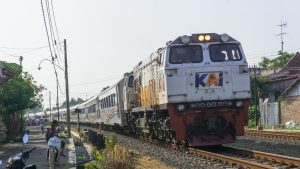The last several years have been eventful ones for Indonesia’s state-owned railway company, Kereta Api Indonesia (KAI). Throughout Jokowi’s 10 years in office, Indonesia has significantly stepped up investment in rail infrastructure, with KAI being one of the primary agents responsible for the construction and operation of new systems. This includes the Greater Jakarta Light Rail Transit system and the Chinese-backed high-speed rail line connecting Jakarta with Bandung, which became operational last year.
As a result of this activity, KAI has seen rapid growth. In 2014, when Jokowi took office, KAI had just over $1 billion in total assets (at current exchange rates). Last year, the company’s total assets came in at $5 billion. Yet there have been lingering doubts about the financial viability of some of these high-profile projects, and about KAI’s balance sheet and ability to incur and carry large amounts of debt. The company released its audited 2023 financial statements last week, so we can now get a better sense of how well-founded these concerns are.
It is true that KAI has been incurring debt in order to fund big projects. At the end of 2023, they had $1.2 billion in long-term loans, and $275 million in outstanding bonds, a bit over $100 million of which will be coming due this year. They also owe the government $159 million from a special loan that was dispensed during the pandemic, and owe state-owned construction company Adhi Karya $257 million for construction services related to the Greater Jakarta LRT. Total liabilities in 2023 were $3 billion.
Is this cause for concern? Probably not. Despite increased liabilities, KAI has around $1.9 billion in equity and remains profitable. Net income last year was $116 million on $2.1 billion in revenue, including $177 million in government subsidies. And because the state is the sole shareholder of KAI, they sometimes do direct capital injections using the national budget. Last year, the state injected nearly $200 million into KAI to help cover costs related to the high-speed rail project.
In fact, were it not for this high-speed rail project there would probably be a lot less scrutiny of KAI’s finances. The project was initially expected to cost $6 billion, but overruns put the final figure closer to $7.2 billion. Because the project was financed primarily by Chinese loans, it has become a politically sensitive flashpoint highlighting the potential risk of using foreign capital to finance nationally strategic development projects.
The high-speed rail is a joint venture between Indonesian and Chinese state-owned firms. The Indonesian side, through a consortium called Pilar Sinergi BUMN Indonesia (PSBI), holds 60 percent ownership of the project. KAI is the primary investor in PSBI, owning 51 percent. In 2023, the first year in which the train was operational, KAI’s participation in this joint venture had a book value of around $350 million, after a net loss of $30.5 million.
Given that KAI had $5 billion in assets and positive net income and cash flow in 2023, this in and of itself probably does not pose a major risk in the short term. But completing the project came with a catch. In order to cover mounting cost overruns, earlier this year the China Development Bank extended loan facilities to KAI worth nearly $543 million. KAI now has over $500 million in new foreign currency-denominated debt for a high-speed rail project that lost tens of millions of dollars last year.
Is this cause for concern? It might be, if the high-speed rail operates at a loss for long enough and if KAI were a typical commercial enterprise. But it’s not. It is owned by the state, and its primary purpose is not to be profitable but to carry out various functions that are in the national interest.
KAI is heavily dependent on the government of Indonesia and other state-owned enterprises for revenue and credit. This means there are many direct and indirect levers the state can pull to ensure that KAI remains a going concern including subsidies, capital injections, relief from track access charges, or rolling over liabilities incurred from other state-owned companies.
This situation will become more complicated in 2024 as the Chinese debt starts to show up on the balance sheet, but even here KAI has access to special privileges that insulate it from typical market risks. In this case, the Indonesian government has provided a guarantee for the $543 million in new debt, which shifts much of the risk from the railway company onto the government. Further state capital injections are also likely in the next budget.
I wrote last week that incurring public debt is not as important as whether or not that debt is used to fund productive investments. Clearly, the Indonesian state believes it is worth it to take on these debts in order to invest in urban transit and high-speed rail, and they have taken steps to ensure Kereta Api Indonesia can function as the primary conduit for such projects. Over the next few years, we will get a better sense of whether or not these bets are paying off.

































